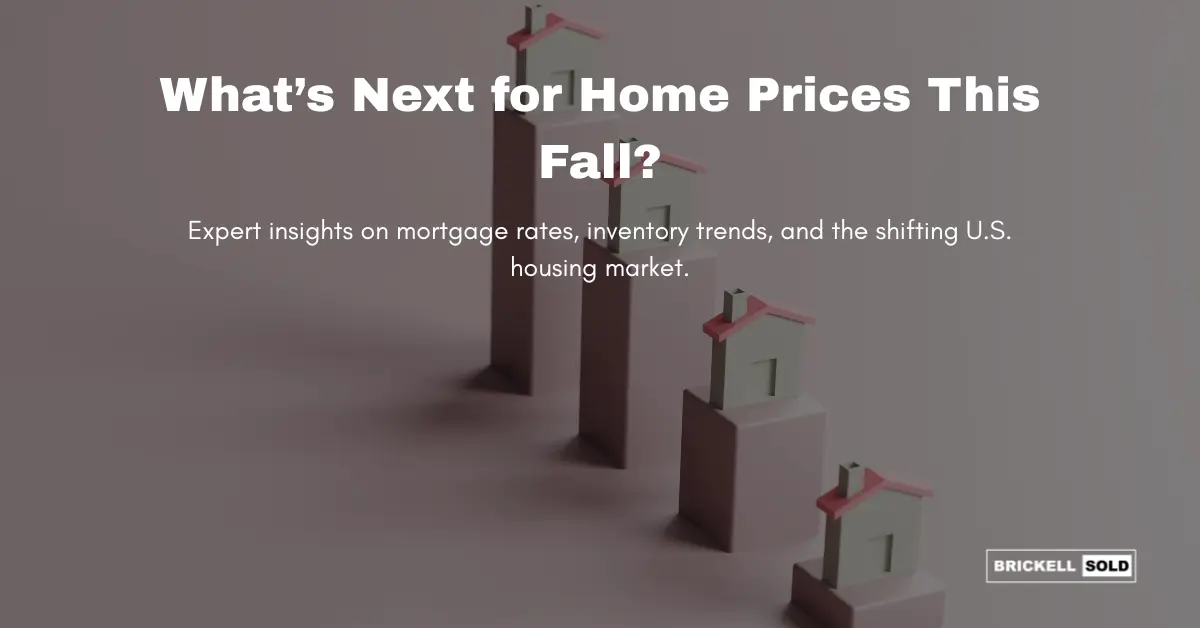As summer draws to a close, the U.S. housing market finds itself in a delicate balance between opportunity and challenge. Buyers are seeing more inventory on the market than they have in years, but stubbornly high mortgage rates and elevated prices continue to squeeze affordability.
Browse affordable new developments and townhomes in the fast-growing Homestead FL real estate market.
While some hopeful homeowners had anticipated a drop in interest rates by now, the Federal Reserve’s cautious approach, combined with broader economic uncertainties, has kept borrowing costs near two-decade highs. This has left both buyers and sellers wondering: What does this fall hold for home prices, inventory trends, and the overall health of the housing market?
This in-depth analysis will explore the current real estate environment, the economic forces at play, and what experts predict for the months ahead.
Explore affordable housing and growing communities in Hialeah FL homes for sale with great ROI potential.
The Current Housing Landscape
The real estate market today is defined by three key trends: rising inventory, persistent affordability challenges, and sluggish buyer demand. According to a recent Zillow analysis, there are now more homes for sale than at any point since 2019. This uptick in inventory is good news for buyers who have faced fierce competition in recent years, but it doesn’t necessarily translate into easy homeownership.
Check out family-friendly neighborhoods and investment-ready listings in Pembroke Pines FL real estate.
One of the biggest reasons is that mortgage rates remain high. The average 30-year fixed mortgage is hovering around 6.75%, roughly the same as last year and more than double the rates seen in 2021. These higher borrowing costs have had a significant impact on monthly payments, effectively pricing many potential buyers out of the market.
Federal Reserve Policy and the Housing Market
The Federal Reserve plays a central role in shaping mortgage rates through its monetary policy. At its most recent meeting, the Fed opted to hold interest rates steady, prioritizing its dual mandate of controlling inflation and maximizing employment.
Discover beachfront condos and gated communities in Hollywood FL homes for sale with instant MLS access.
However, this decision was influenced by broader economic uncertainties, including trade policy concerns such as ongoing tariffs. Without a rate cut, mortgage rates have remained elevated, leaving little immediate relief for homebuyers.
Fed Chair Jerome Powell summarized the situation succinctly during a press conference: “Activity in the housing sector remains weak.” This weakness is reflected in slower sales volumes and homes spending more time on the market.
View luxury condos, waterfront towers, and gated homes in Aventura FL real estate listings for savvy buyers.
Sales Slowdown and Price Trends
Data from the National Association of Realtors (NAR) shows that sales of previously occupied U.S. homes slid in June to their slowest pace since the previous September. At the same time, the national median sales price hit an all-time high of $435,300.
NAR Chief Economist Lawrence Yun attributes this stagnation to high mortgage rates: “High mortgage rates are causing home sales to remain stuck at cyclical lows.”
Find your dream coastal home with top picks from the Fort Lauderdale real estate market—perfect for living or investing.
While prices remain historically high, the pace of appreciation is expected to slow in the coming months. Realtor.com forecasts that mortgage rates will ease slightly later this year, potentially reaching around 6.4% by the end of 2025. This may provide modest relief, but the impact on affordability will likely be limited.
Invest early in the booming market of Miami new construction homes and condos in top-performing zip codes.
Affordability: The Central Challenge
Even if mortgage rates drop to 6%, homeownership will remain out of reach for many Americans. Zillow economist Anushna Prakash calculates that rates would need to fall to about 4.43% for a typical home to be affordable to someone earning the median income. This type of drop is unlikely without significant economic trade-offs, such as slower economic growth, reduced income gains, and higher unemployment.
Explore the hottest Miami pre construction condos for sale offering luxury, location, and long-term investment value.
In practical terms, the cost of buying a home has risen dramatically in recent years. In 2020, the typical monthly mortgage payment was around $1,100. By 2024, it had doubled to $2,207 (not adjusted for inflation). Even after accounting for inflation, that’s an increase of about $800 per month.
Stay informed with the latest trends and opportunities in the Miami real estate investment market from our expert-led blog.
How Buyers and Sellers Are Adapting
High borrowing costs have forced buyers to adjust their strategies. Many are:
-
Expanding their search to more affordable areas or smaller homes
-
Considering longer commutes in exchange for lower prices
-
Exploring alternative financing options such as adjustable-rate mortgages
-
Waiting in hopes of more favorable conditions in the future
Sellers, on the other hand, are facing a different challenge. With more homes on the market, competition is increasing. This has led to:
-
More willingness to negotiate on price
-
Offering concessions such as covering closing costs or funding repairs
-
Investing in home staging to attract buyers
Search the best deals in Miami FL real estate for sale including luxury condos, townhomes, and waterfront properties.
Regional Differences in the Market
Not all housing markets are behaving the same way. In some regions, particularly in the West and parts of the Sun Belt, prices have begun to decline slightly as inventory rises. These areas saw some of the sharpest price increases during the pandemic, and the correction reflects a rebalancing.
Discover high-rise living and waterfront options in the Brickell Miami condos for sale updated with real-time listings.
Meanwhile, other regions with strong job growth and limited housing supply, such as parts of the Midwest and Northeast, continue to see prices rise, albeit at a slower pace. Local economic conditions, population growth, and housing supply constraints all play a role in these differences.
The Silver Lining: Slower Price Growth
One positive development for buyers is the expected moderation in price growth. After years of double-digit annual gains, prices are now projected to increase at a much slower pace. This doesn’t solve the affordability problem overnight, but it does reduce the urgency and competitive pressure that characterized the market during the pandemic.
Get expert insights on market trends, new projects, and deals in our Brickell Miami real estate blog.
As more homes come on the market, buyers have more time to make informed decisions rather than rushing into bidding wars. In some areas, this shift is giving buyers the upper hand for the first time in years.
Browse curated listings and upcoming developments in Florida pre construction homes for sale across key cities.
Expert Advice for Navigating the Market
Given the uncertainty surrounding interest rates, inflation, and the broader economy, experts recommend that consumers take proactive steps to strengthen their financial position:
-
Pay down high-interest debt – This frees up more income for housing costs and reduces overall financial risk.
-
Build emergency savings – A solid safety net can help weather unexpected expenses or job disruptions.
-
Get pre-approved for a mortgage – Knowing your budget and securing financing early can give you an advantage when you find the right home.
-
Work with a knowledgeable agent – Local expertise can be invaluable in identifying good opportunities and negotiating effectively.
Looking Ahead to the Rest of 2025
Realtor.com expects the second half of 2025 to mirror the modest activity of the spring, which was one of the slowest in years. While lower mortgage rates could stimulate demand somewhat, they are unlikely to return to the historically low levels seen in 2020 and 2021.
For buyers, patience and preparation will be key. For sellers, realistic pricing and flexibility will increase the likelihood of a successful sale.
Final Thoughts
The housing market this fall is a story of contrasts. On one hand, inventory is improving, giving buyers more choices and reducing competition. On the other hand, high mortgage rates and record prices continue to make affordability a major obstacle.
While no one can predict the future with absolute certainty, the consensus among economists is that we are entering a period of slower, steadier growth. This may not be the dramatic shift some had hoped for, but it represents a healthier, more sustainable path for the housing market in the long term.
For now, both buyers and sellers should stay informed, flexible, and financially prepared to adapt to changing conditions.

